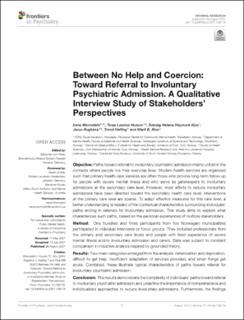| dc.description.abstract | Objective: Paths toward referral to involuntary psychiatric admission mainly unfold in the contexts where people live their everyday lives. Modern health services are organized such that primary health care services are often those who provide long-term follow-up for people with severe mental illness and who serve as gatekeepers to involuntary admissions at the secondary care level. However, most efforts to reduce involuntary admissions have been directed toward the secondary health care level; interventions at the primary care level are sparse. To adapt effective measures for this care level, a better understanding is needed of the contextual characteristics surrounding individuals’ paths ending in referrals for involuntary admission. This study aims to explore what characterizes such paths, based on the personal experiences of multiple stakeholders. Method: One hundred and three participants from five Norwegian municipalities participated in individual interviews or focus groups. They included professionals from the primary and secondary care levels and people with lived experience of severe mental illness and/or involuntary admission and carers. Data was subject to constant comparison in inductive analysis inspired by grounded theory. Results: Four main categories emerged from the analysis: deterioration and deprivation, difficult to get help, insufficient adaptation of services provided, and when things get acute. Combined, these illustrate typical characteristics of paths toward referral for involuntary psychiatric admission. Conclusion: The results demonstrate the complexity of individuals’ paths toward referral to involuntary psychiatric admission and underline the importance of comprehensive and individualized approaches to reduce involuntary admissions. Furthermore, the findings indicate a gap in current practice between the policies to reduce involuntary admissions and the provision of, access to, and adaptation of less restrictive services for adults with severe mental illness at risk of involuntary admissions. To address this gap, further research is needed on effective measures and interventions at the primary care level. | en_US |

